|
Suppose C is a category with fibre products. Definition 5.1.1. Suppose X,
S are two objects and i, j are two morphisms from
X to S. The kernel
(or equalizer) of i and
j is an object ker(i,j), together with a map
p: ker(i,j) ®
X such that ip = jp, which has the following universal
property:
Note that p is a monomorphism representing the subfunctor Definition 5.1.2. Suppose X is an object over S with the structure morphism f: X ® S. A morphism s: S ® X such that fs = 1S is called an S-section of X. (Thus an S-section of X is an S-morphism s: S ® X.) The set of S-sections of X is denoted by G(X/S). Definition 5.1.3. Suppose X and Y are objects over S. Suppose f: X ® Y is an S-morphism. The morphism (1X, f)S: X ® X ×S Y over S is called the graph morphism of f, denoted Gf, which is an X-section of X ×S Y. If Y = X and f = 1X, then the graph morphism of 1X is called the diagonal morphism of X over S, denoted DX/S (or simply DX, or Df, or D). Remark 5.1.4. Suppose X, Y are two objects over S. The map f ® Gf = (1X, f)S is a bijection: The relationship of these concepts are exhibited in the following lemmas. (The proofs are straightforward which will be omitted.) Suppose u: X ® S is a morphism. Consider an S-object T and an S-morphism t: T ® X ×S X = W. Form the fibre product (X ×W T, i, j) as below: 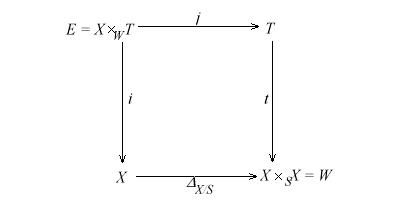 Lemma 5.1.5. Suppose g, h: T ® X are two S-morphisms with t = (g, h)S. Then E = ker (g, h) is the kernel of g and h: 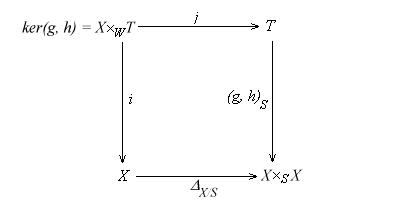 Lemma 5.1.6. Suppose T = X, and s: S ® X is an S-section of u: X ® S with t = (su, 1X). Then E = S and i = j = s canonically: 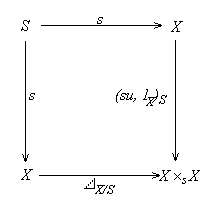 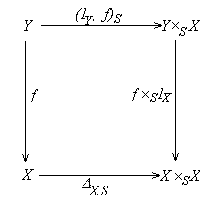 Lemma 5.1.8. Suppose f: Y ® X, g: Z ® X are two S-morphisms with T = Y ×S Z and t = f ×S g. Then E = Y ×X Z canonically. We have j = (p, q)S and i = fp = gq, where p: Y ×X Z ® Y and q: Y ×X Z ® Z are projections: 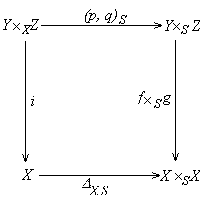 Proposition 5.1.10. (a) Any
regular monomorphism is a mono.
Proof. (a) is obvious and (b) follows from (5.1.6, 5.1.7, 5.1.8); (c) comes from (5.1.5); (d) follows from (c) and (4.2.6d). Proposition 5.1.11. Suppose P is
a property of morphisms satisfying the following conditions:
Proof. Suppose P satisfies the conditions (a) and (b). We have fS' = f ×S 1S'. Therefore (i) implies (ii) by (a). On the other hand, f ×S g is the composite morphism Hence (ii) implies (i) by (b). Proposition 5.1.12. Suppose P is
a property of morphisms having the following properties:
Proof. Note that f can be factored as where q is the second projection and q = (gf) ×Z 1Y: X ×Z Y d Z ×Z Y = Y. Then q has the property P by (b). Since Gf is a special morphism, f has the property P by (a). Proposition 5.1.13. Suppose C
is a site. Suppose P is a property of morphisms having the following
properties:
Proof. Note that f can be factored as where q is the second projection and q = (gf) ×Z 1Y as in (5.1.12). Then q has the property P by (b). By (5.1.7) Gf is the result of Dg under a base extension (see the diagram below), thus a closed regular monomorphism, since by assumption Dg is universally closed. Hence f has the property P by (a). 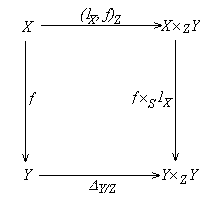
|